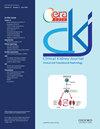非扩张性阻塞性肾病
IF 3.9
2区 医学
Q1 UROLOGY & NEPHROLOGY
引用次数: 0
摘要
梗阻性肾病(ON)是肾移植后急性肾损伤(AKI)的一种常见且可逆的原因,可能由多种疾病引起。当两个上尿路都受阻或单侧肾脏患者的一个上尿路受阻时,就会发生阻塞性肾病。只要影像学检查有肾积水的证据,就会怀疑是 ON。然而,并非所有梗阻患者都会出现肾积水,在没有肾积水的情况下也可能存在明显的梗阻。这种综合征被称为非扩张性梗阻性尿病(NDOU)。它约占尿路梗阻病例的 5%,诊断具有挑战性。本文对相关文献进行了综述,旨在确定 NDOU 的主要病因及其临床表现,从而明确在 AKI 病例中何时应怀疑 NDOU。由于现有证据的总体质量较低,因此本文进行了叙述性综述。只有肾功能衰竭后、肾内集合系统未扩张或扩张极小的患者才被纳入其中。我们的研究表明,NDOU 在第五和第六个十年中最为常见,主要影响男性。入院时血清肌酐水平通常很高。最常见的临床表现包括少尿/无尿、腹痛、水肿或胸腔积液等潴留症状以及恶心/呕吐。大约四分之三的 NDOU 病例是由于腹膜后纤维化或恶性疾病导致输尿管腹外受压。输尿管支架置入术或经皮肾造瘘术可实现有效的微创尿流改道。NDOU 的正确诊断可能具有挑战性,但却至关重要,因为它可以导致及时的治疗,并有可能完全解除梗阻和急性肾衰竭。本文章由计算机程序翻译,如有差异,请以英文原文为准。
Non-dilated obstructive nephropathy
Obstructive nephropathy (ON) is a common and reversible cause of post-renal acute kidney injury (AKI) and may be caused by a variety of conditions. It occurs when both the upper urinary tracts are obstructed or when one tract is obstructed in patients with a solitary kidney. ON is suspected whenever there is evidence of hydronephrosis at imaging. However, not all patients with obstruction develop hydronephrosis and significant obstruction can be present in the absence of hydronephrosis. This syndrome is called non-dilated obstructive uropathy (NDOU). It accounts for about 5% of cases of urinary obstruction and the diagnosis can be challenging. The current paper provides an overview of the literature aiming to identify the main causes NDOU and its clinical presentation, in order to clarify when to suspect it among AKI cases. A narrative review was performed due to the overall low quality of the available evidence. Only patients with post-renal AKI and a non-dilated or minimal dilation of the intrarenal collecting system were included. As evidenced by our review, NDOU is most prevalent in the fifth and sixth decade of life and affects mainly the male gender. On hospital admission serum creatinine levels are usually very high. Among the most common clinical presentations are the oliguria/anuria, abdominal pain, signs of retention like oedema or pleural effusion and nausea/vomiting. About three out of four cases of NDOU are due to an ab-extrinsic compression of the ureters caused by retroperitoneal fibrosis or malignant disease. An effective and minimally invasive urinary diversion is obtained with ureteric stenting or a percutaneous nephrostomy. A correct diagnosis of NDOU may be challenging but it is of paramount importance as it can lead to a prompt management with a potential complete resolution of both obstruction and acute renal failure.
求助全文
通过发布文献求助,成功后即可免费获取论文全文。
去求助
来源期刊

Clinical Kidney Journal
Medicine-Transplantation
CiteScore
6.70
自引率
10.90%
发文量
242
审稿时长
8 weeks
期刊介绍:
About the Journal
Clinical Kidney Journal: Clinical and Translational Nephrology (ckj), an official journal of the ERA-EDTA (European Renal Association-European Dialysis and Transplant Association), is a fully open access, online only journal publishing bimonthly. The journal is an essential educational and training resource integrating clinical, translational and educational research into clinical practice. ckj aims to contribute to a translational research culture among nephrologists and kidney pathologists that helps close the gap between basic researchers and practicing clinicians and promote sorely needed innovation in the Nephrology field. All research articles in this journal have undergone peer review.
 求助内容:
求助内容: 应助结果提醒方式:
应助结果提醒方式:


